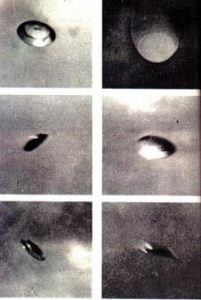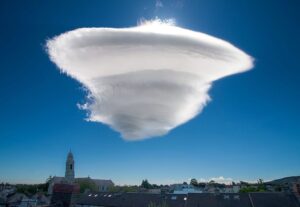Nov
6
When Is a UFO Not a UFO?, Part 2
“The more you investigate, the more likely you are to find that there is LESS to these stories than meets the eye.” — astronomer Andrew Fraknoi, Science Education and Outreach: Forging a Path to the Future journal
Continuing from Part 1, we again consider the question asked in the post’s title: When is a UFO not a UFO?

Perhaps the most important and substantive answer is, “when it has been identified.” There are many circumstances in which the average person — and even some highly-educated people in various disciplines — cannot identify what a strange object is, thus earning it the “UFO” or “UAP” label. But, just because a thing isn’t initially identified or explained doesn’t mean it can’t be, and one need not jump to the conclusion that extraterrestrials or their technology is involved.
A huge part of what UFO investigators do — or, those who at least try to be objective (e.g., J. Allen Hynek, Allan Hendry, Jerome Clark, Jacques Vallée) — is gather as much evidence as possible to determine if there is a reasonable, natural or human-caused explanation for what was witnessed. When such a mystery is solved in this way, it becomes an “identified flying object” (IFO), or perhaps now an “identified aerial phenomenon” (IAP).
The book Lights in the Sky & Little Green Men (2002) presents the following eight categories of natural explanations (which I have added to in a couple places):
— — —
Misidentified Natural Phenomena. UFO reports often result from the misidentification of seemingly mysterious, but nevertheless natural, phenomena. The Center for UFO Studies (CUFOS) comments concerning misidentified natural phenomena:
“People report natural or conventional objects as UFOs because they do not recognize them as such due to unusual environmental conditions, ignorance, or the rarity of a natural event. For example, people have reported the planet Venus as a UFO, unaware of how bright the planet can appear at certain times of the year. Stars near the horizon are sometimes reported as UFOs because atmospheric turbulence and thermals (columns of warm air) cause them to twinkle rapidly in red and blue colors. Stars may also appear to dart back and forth because of autokinesis. This is a psychological phenomenon in which a person’s eye movements create the illusion that a bright object seen in the dark without frame of reference is moving.”
Some of the natural objects or effects that commonly stimulate UFO reports include the following:
- the moon, stars, and planets (for example, the cusps of a rising crescent moon in the tropics, Venus at maximum brightness, the Pleiades, and star clusters)
- unusual weather conditions (such as lenticular cloud formations, noctilucent clouds, rainbow effects, and high-altitude ice crystals)
- comets
- meteor swarms
- near or large meteors
- flocks of birds (sometimes carrying phosphorescent dust on their bellies and wings)
- swarms of flying insects
- reflections from atmospheric inversion layers
- hot ionized gas (natural or man-made)
- Earth lights (luminous electrical events from low-level earthquakes and tectonic-geological phenomena)
- ball lightning
- reflected light (especially through broken clouds_
- aurora borealis (the northern lights) or aurora australis (the southern lights)
- sun dogs and moon dogs (lights on either side of the sun or moon caused by atmospheric distortions)
- red or green flashes (false solar images seen before sunrise or after sunset in high-altitude regions)
Misidentified Man-made Phenomena. UFO reports may be provoked by the following man-made stimuli:
- balloons (meteorological, passenger, toy, surveillance, research)
- military aircraft
- unmanned drones (military, commercial, private)
- unconventional aircraft or secret, advanced technology (for example, the SR-71 Blackbird or the B-2 Stealth bomber)
- aircraft with unusual external light patterns
- advertising planes
- artificial earth satellites
- hovering aircraft (such as a helicopter or VTOL jet)
- blimps
- rockets and rocket launches
- kites
- fireworks
- lasers aimed at the clouds
- searchlights
False Images Resulting from High-Quality Instruments. Even the best instruments, including radar scopes, will produce ghost images under certain conditions. Every surface of a lens system can pick up reflections. Because many cameras have eight or more such surfaces, the potential for false image generation is significant. Any optical aids of the witness (eyeglasses, binoculars, and so on) must also be considered as a possible cause of a false image.

False Images Resulting from Faulty Instruments or Harsh Environments. Human error in the operation of instruments or mechanical failures that produce false images can result in UFO reports. False images may result from false radar readings (reflections, interference, indiscriminate detection) and photographic distortions (superimposed images caused by reflected light from such things as windows and eyeglasses). The environment sometimes causes false images. For example, photographic emulsions respond differently to environmental conditions. A cold, dark, drizzly day will produce a “UFO” in one emulsion, whereas a hot, dry, bright day will generate a “UFO” on a different emulsion. Also, if the camera’s film is mechanically stressed or stretched, it can produce a variety of false images.
False Images Resulting from Faulty Human Perception. Problems associated with human perception, especially optical defects (including distortions of sight, floaters in the eye, optical illusions, and mirages), may generate UFO reports. The most common false report in this category arises from the lack of adequate dark adaptation on the part of the observer. If fewer than ten minutes have passed between the witness’s exposure to bright light and his or her nighttime UFO observation, a high probability exists that the UFO is a false image.
Hoaxes, Pranks, or Fraud. Deliberate deception can prompt UFO reports. The types of UFO hoaxes are many; examples include the following:
- false or embellished testimony
- faked photography
- disk-shaped objects artificially suspended in the sky
- radio-controlled or programmed UFO look-alike craft
- cleverly crafted balloons, rockets, and models
- landing site frauds
- alien crash site and retrieval frauds
- fraudulent abductee and contactee claims
Concerning UFO hoaxes, CUFOS notes the following:
“Although tens of thousands of UFOs have been reported over the past forty years, less than 1% have been shown to be hoaxes. For the most part, competent UFO investigators have been able to recognize hoaxes almost immediately. The most common type of UFO hoax is a prank balloon, which involves tying a flare or candle to a helium-filled balloon. On rare occasions elaborate hoaxes have been perpetrated, necessitating a more extensive investigation.”
Thus, while hoaxes, pranks, and frauds should be considered when a suspicious claim is made, this explanation is less common than most others.
Nonempirical, Subjective Causes. Sometimes UFO reports have no basis in objective, empirical reality but instead result from a broad range of inner and subjective factors, including the following:
neurological stimuli (for example, temporal lobe dysfunction)
sociological stimuli (for example, cultural creations, myths, or conditioning)
psychological stimuli (for example, psychosis, hysteria, sleep deprivation, paranoia, hallucination)
These factors are the province of social scientists. John A. Saliba explains how social scientists typically approach the subject of UFOs:

“Social and behavioral scientists have… raised several issues regarding the meaning of UFO sightings and encounters, issues which have hardly surfaced in popular literature and are usually ignored or downplayed by ufologists. They have changed the more customary focus of UFO investigations — which is to verify UFO reports — by suggesting that since the UFO problem is not likely to be resolved in the near future, there is more to be gained by examining their sociopsychological significance. The meaning of the flying saucer phenomenon might lie more in its social and psychological dimensions than in whether extraterrestrials exist or not, or in what the aliens themselves are supposedly saying and doing. In other words, belief in flying saucers and alleged encounters with their occupants might reveal something important about human nature, the study of which is central to the social, psychological, and psychiatric disciplines.”
Combinations of Natural and Human Factors. UFO reports may be initiated by a combination of natural factors. For example, a geophysical event may trigger a physiological response in the observer, which then may cause a psychological experience (hallucination). Canadian neuropsychologist Michael A. Persinger argues that many UFOs can be explained in this manner. Another example is an aircraft that may appear unusual under uncommon weather conditions. Yet another example is the way the light of the sun may reflect off an aircraft’s fuselage, creating a strange image.
— — —
Of course, these types of explanations rarely satisfy the True Believers in extraterrestrial beings. Plus, there is the undeniable fact that some UFO sightings remain unexplained even after considering the above possibilities. Though earlier studies have higher numbers, current estimates range from 1% (or fewer) to nearly 10% of cases remaining unsolved. These are called “residual UFOs” (RUFOs), and I will address them in an upcoming post.















